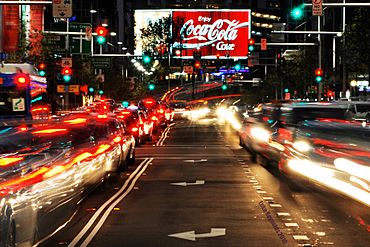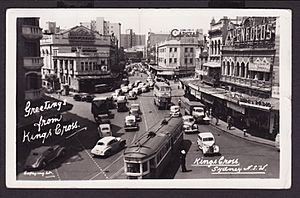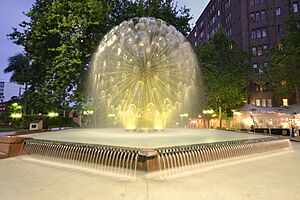Kings Cross, New South Wales facts for kids
Kings Cross is an area in Sydney, New South Wales, Australia. It is about 2 kilometres east of the main city centre. This area is part of the City of Sydney. It is surrounded by other suburbs like Potts Point, Elizabeth Bay, Rushcutters Bay, and Darlinghurst.
People often call Kings Cross "The Cross". It was once famous for its music halls and big theatres. After World War II, many soldiers came back, and the area changed a lot. It became known as a busy place for entertainment at night. However, many nightclubs and bars closed because of new rules that made places close earlier. Today, Kings Cross is a mixed area with useful services like a railway station, gyms, supermarkets, and bakeries. It also has many fun places like bars and restaurants.
Quick facts for kids Kings CrossSydney, New South Wales |
|||||||||||||||
|---|---|---|---|---|---|---|---|---|---|---|---|---|---|---|---|

Coca-Cola billboard, Kings Cross
|
|||||||||||||||
| Population | 4,948 (2019) | ||||||||||||||
| Location | 2 km (1 mi) east of Sydney CBD | ||||||||||||||
| LGA(s) | City of Sydney | ||||||||||||||
| State electorate(s) | Sydney | ||||||||||||||
| Federal Division(s) | Wentworth | ||||||||||||||
|
|||||||||||||||
Contents
History of Kings Cross
How Kings Cross Got Its Name
The main intersection in the area was first called Queen's Cross in 1897. This was to celebrate Queen Victoria's 60th year as queen. But people often confused it with Queen's Square in King Street. So, in 1905, it was renamed Kings Cross after King Edward VII.
In the early 1800s, the Darlinghurst area, which included what is now Kings Cross, was a very fancy place in Sydney. It was far enough from the city's noise and smells but still easy to reach. People also loved the amazing views of the harbour and even the Blue Mountains.
In 1828, the Governor of New South Wales, Sir Ralph Darling, divided the land. He gave large pieces of land to important people and businessmen. They built grand mansions with huge gardens. Many street names today, like Roslyn, Orwell, and Kellett, remember these old homes. Most of these big estates were later divided, and many mansions were pulled down. One of the homes that still stands is Elizabeth Bay House, a beautiful example of old Australian architecture.
Early Land Development
The large pieces of land given by Governor Darling helped shape how Kings Cross grew. The mansions built on these lands, like Tusculum, are still important examples of early Australian design.
From the mid-1800s to the mid-1900s, maps were made to advertise land for sale. These maps show how Sydney grew as big estates were divided into new suburbs.
The names of the old estates and mansions are still used for streets today. For example, Roslyn Street is named after Roslyn Hall, Orwell Street after Orwell House, and Kellett Street after Kellett House. You can see these old plans in the image gallery below.
A Creative and Lively Area
From the early 1900s, Kings Cross was known as a place for artists and creative people. Many writers, poets, actors, and painters lived there. These included famous names like Kenneth Slessor and Sir William Dobell. The "Cross" was also a big entertainment hub with many clubs and cafes. It even had one of Sydney's first movie theatres, the Kings Cross Theatre.
From the 1960s onwards, Kings Cross became a major spot for tourists and entertainment. Many American soldiers on leave visited the area for fun. A positive influence in the area was the Wayside Chapel, run by Rev Ted Noffs. His church was always open, offering a safe place and help to many people in the area. The Ted Noffs Foundation, started in 1971, still helps young people and their families today.
Juanita Nielsen, a journalist, worked to protect the Kings Cross area from too much building development in the 1970s. She disappeared on July 4, 1975. An investigation later found that she had been murdered. Although the case was never officially solved, many believe she was killed because of her work against developers. Some building projects she fought against were stopped or changed because of community efforts.
In 1978, the first Sydney Gay and Lesbian Mardi Gras march happened to support gay rights. After the march, some people went to Kings Cross, where police arrested 53 people. Most of these charges were later dropped.
Australia's first widely known transgender performer, Carlotta, became famous in Kings Cross. She performed in cabaret shows at places like Les Girls.
Kings Cross Today
Today, Kings Cross has a mix of people living there and visiting. This is because of its tourist accommodation, nearby social housing, healthcare services, and easy public transport to the city. After new rules were put in place in March 2014, some nightclubs and pubs in the area closed down.
In February 2021, the government announced that these rules would end in March 2021. This was done to help the area become lively again.
Important Places
Kings Cross has several important historical sites:
- The El Alamein Fountain is at the entrance to Fitzroy Gardens. It was built in memory of soldiers who died in 1942 during World War II battles in El Alamein, Egypt. It was designed in 1961 by Robert Woodward. Its unique "dandelion" design has been copied for fountains around the world.
- The Coca-Cola billboard was a famous landmark. It was turned off and replaced with a new sign in 2016. Parts of the original sign were sold to raise money for the Wayside Chapel.
- The Fire Station at Darlinghurst Road and Victoria Street was built between 1910 and 1912. It is a good example of the Federation Free Style of architecture.
- Kings Cross railway station is an underground train station on the Eastern Suburbs & Illawarra Line of the Sydney Trains network.
- The Les Girls building, now called the Empire Hotel, was a well-known spot. From 1963 to 1993, it was home to the famous Les Girls "drag queen" show, starring Carlotta.
Culture and Fun
Events and Celebrations
- The Kings Cross Food and Wine Festival is a yearly event held in autumn. It is organized by local businesses.
Kings Cross in Popular Culture
Kings Cross has appeared in many Australian books, movies, and songs:
- The TV show Kings Cross ER: St Vincent's Hospital showed medical emergencies happening in Kings Cross.
- Paul Kelly's song "From St Kilda to Kings Cross" is about the area.
- The 1999 Australian crime movie Two Hands, starring Heath Ledger, was partly filmed in Kings Cross.
- The novel The Golden Day by Ursula Dubosarsky is set in a fictional girls' school in Kings Cross.
- The novel Down in the City (1957) by Elizabeth Harrower is mostly set in Kings Cross.
- The 1988 Australian film Tender Hooks is largely set in Kings Cross.
- The Australian TV series Underbelly: The Golden Mile was set in Kings Cross. It showed a dramatic story of organized crime in the 1980s and 1990s.
- The Australian TV series Love Child was set in Kings Cross. It was a drama about teenagers in the 1960s.
- The Australian TV series Les Norton was set in Kings Cross. The main character worked as a bouncer in an illegal gambling place in 1985.
- The Australian TV series Last King of the Cross is set in Kings Cross. It shows the early life of John Ibrahim as he became well-known in the area.
Population
In 2019, it was estimated that 4,948 people lived in the Kings Cross area, which is about 0.17 square kilometres. In 2018, the wider local area (including Potts Point and Woolloomooloo) was one of the most densely populated places in Australia.
See also
- Uniting Medically Supervised Injecting Centre (a facility in Kings Cross that helps people)












